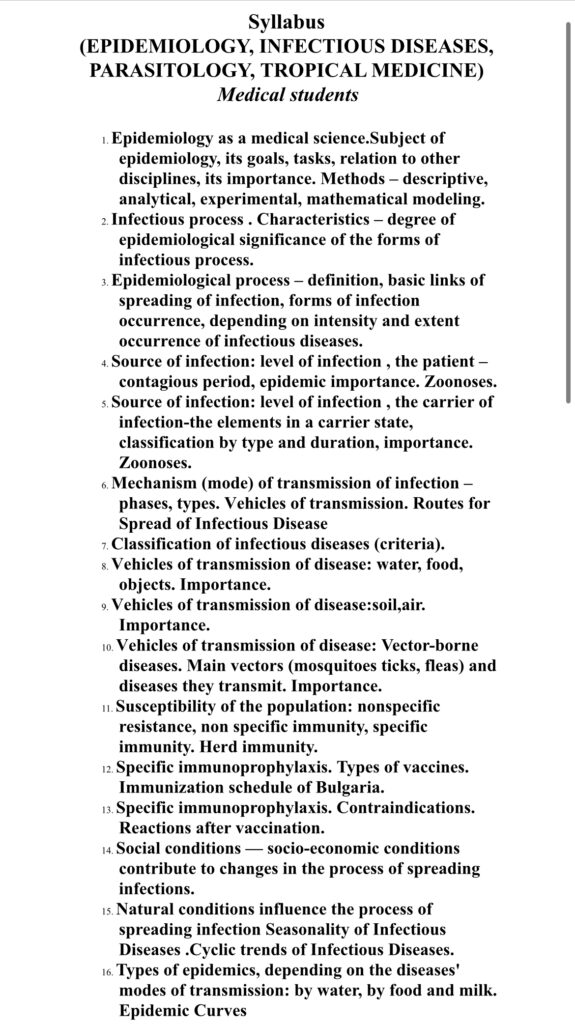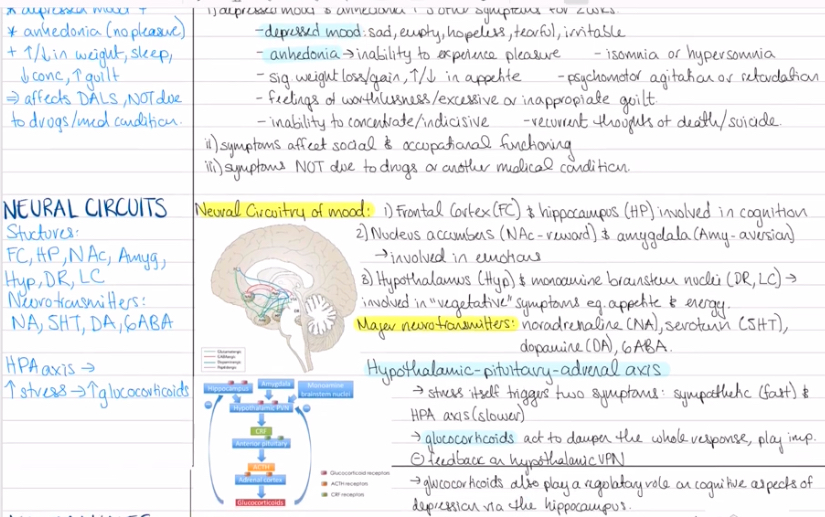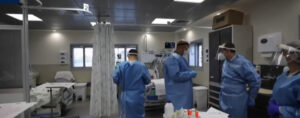海外医学部でのシラバス重視の学び方について

海外医学部でのシラバス重視の学び方
海外医学部での学びにおいて、シラバスに沿った勉強とノート作成は、進級や卒業に極めて重要な要素です。ここでは、その理由と具体的な勉強法について解説します。
シラバスとは何か
シラバスとは、授業計画や内容、成績評価方法などを明記したもので、学生や教員が授業を円滑に進めるための指針となる資料です。主な内容には以下があります。
- 授業の目的・到達目標
- 授業内容・方法
- 授業計画
- 成績評価方法・基準
シラバスは学生と教員が授業計画を共有する「契約書」のような役割を果たし、語源はラテン語で、日本では明治時代に「教授要目」として定着しました。
海外医学部におけるシラバスの重要性
医学部で学ぶ内容は膨大であり、何を優先的に学ぶべきかを明確にするためにシラバスが必要です。例えば、解剖学や生理学、臨床実習に至るまで、欧州医学部では共通してシラバスに記載されたトピックを押さえることが求められます。
シラバスを活用することで以下の効果があります。
- 重要な情報を見逃さず、計画的に学習を進められる
- 試験範囲を把握し、効率的に対策を立てられる
- 教授陣との意思疎通が円滑になり、質問やディスカッションで自信を持って発言できる
ノート作成の意義
授業で得た知識を整理し、理解を深めるためにノート作成は不可欠です。特に医学分野では知識量が膨大であるため、シラバスに沿った体系的なノート作成が試験対策や卒業試験に直結します。
具体的には以下のような方法が有効です。
- シラバスのトピックごとにノートを整理する
- 重要事項は色分けや図表で視覚化する
- キーワードや概念を繰り返し書き出し、記憶を定着させる
具体例:疫学・感染症・寄生虫学・熱帯医学のシラバス
以下は、欧州医学部で実際に用いられる「EPIDEMIOLOGY, INFECTIOUS DISEASES, PARASITOLOGY, TROPICAL MEDICINE」に関するシラバスの一部です。

シラバス抜粋(英語原文)
- Epidemiology as a medical science. Subject, goals, tasks, relation to other disciplines, importance. Methods – descriptive, analytical, experimental, mathematical modeling.
- Infectious process. Characteristics – degree of epidemiological significance.
- Epidemiological process – definition, basic links, forms of infection occurrence.
- Source of infection: patient, contagious period, zoonoses.
- Carrier of infection: classification, zoonoses.
- Transmission mechanism – phases, types, routes of spread.
- Classification of infectious diseases (criteria).
- Vehicles of transmission: water, food, objects.
- Vehicles of transmission: soil, air.
- Vector-borne diseases: main vectors (mosquitoes, ticks, fleas).
シラバス抜粋(日本語訳)
- 疫学とは。対象、目的、課題、他分野との関係、方法(記述的、分析的、実験的、数学的モデリング)
- 感染プロセスの特徴と疫学的重要性
- 疫学的プロセス – 定義、感染拡大の基本要素、感染症発生形態
- 感染源:患者、感染期間、人獣共通感染症
- 感染キャリア:分類、人獣共通感染症
- 感染伝播メカニズム – 段階、タイプ、感染経路
- 感染症分類(基準)
- 伝染媒体:水、食物、物体
- 伝染媒体:土壌、空気
- 媒介動物による病気:蚊、ダニ、ノミ
試験対策に役立つシラバスに基づいた体系的ノート作成術
試験対策において、シラバスに基づいた体系的なノート作成が非常に効果的です。各トピックを要点ごとに整理し、選択式、筆記、口述試験など、どの形式にも瞬時に対応できるレベルまでトレーニングを重ねることが重要です。筆者自身も、試験対策ノートを作成する際に、重要なキーワードや概念を視覚的に整理し、理解を深める工夫をしました。このプロセスによって知識が確実に定着し、試験本番でも自信を持って臨むことができました。成功への鍵は、「体系的なまとめ」と「反復練習」にあります。
シラバスに基づいたノート作成の具体例
以下は、シラバスに基づいて試験対策を行った際に作成したノートの一例です。※写真はイメージで、ノート抜粋とは別物です。

1 – Epidemiology as a medical science. Subject of epidemiology, its goals, tasks, relation to other disciplines, its importance. Methods – descriptive, analytical, experimental, and mathematical modelling
Epidemiology as a medical science; its goals, tasks, relation to other disciplines, and its importance
Definition: An independent branch of medicine studying etiology and spreading of infectious diseases in a human community and is aimed at prevention, control, and final eradication of these diseases.
- Classical epidemiology: The study of the determinants and distribution of disease in populations.
- Clinical epidemiology: The study and application of epidemiology principles and methods to the clinical setting.
- General epidemiology: Studies the laws of distribution of infectious diseases among people (characteristics of sources of infection, the mechanism of transmission, susceptibility to infection, etc.) and the general principles of prevention and control of these diseases.
- Special epidemiology: Studies epidemiologic characteristics of each particular infectious disease and the methods to prevent and control it.
Epidemiology studies the triad of parasites, macroorganisms, and the environment.
Aims of epidemiology:
- Describe the distribution, the pattern, and the natural history of disease in the general population.
- Identify factors that may be causal in a disease process, and evaluate strategies for the control, management, and prevention of a disease.
- Ultimate aim: Eliminate/eradicate infections within the population.
Tasks of epidemiology in public health practice:
- Public health surveillance
- Field investigation
- Analytic studies
- Evaluation
- Linkages
- Policy development
Methods – Descriptive
- Aims to determine the incidence of the disease, the risk factors, and its medico-social significance, and to formulate the hypothesis for possible prevention and control measures.
- Characteristics: No intervention; patients are observed, and the clinical course of the disease is studied. The observations are used to form a hypothesis.
- Involves determination of incidence, prevalence, and mortality rates for diseases in large population groups.
Examples:
- Incidence study: Determines the incidence of a particular event in a population during a certain period; often performed as cohort studies.
- Correlation study: Unit of analysis is the entire population; conclusions apply to the population, not individuals. (e.g., correlation between wine consumption and death due to CVS disease)
- Case report: Report of a disease presentation, treatment, and outcome in a single subject; lacks generalizability and cannot assess causality.
- Case series report: Aggregates several similar patient cases; subject to selection bias and cannot assess causality. (e.g., cases of pericarditis at a local hospital)
- Ecological study: Assesses links between exposure and outcomes; useful when outcomes are rare.
- Cross-sectional study: Determines prevalence of exposure and disease at a specific point in time.
Methods – Analytical
Studies attempting to explain disease. They establish causal relationships between risk factors and morbidity to test and evaluate hypotheses about risk factors.
- Randomised controlled trials (RCTs; interventional studies): Gold standard; determines the effect of a specific intervention. Patients are randomly allocated as treatment or control subjects; minimizes bias and demonstrates causality, but is expensive and time-consuming.
- Cohort study: Studies incidence rate and association between exposure and outcome; examines large populations over long periods; determines how one exposure leads to multiple outcomes.
Methods – Experimental
- Simulation of epidemic processes on lab animals, and rarely on humans if the infection does not threaten life.
- Experimental animals divided into experimental and control groups.
- Aim: Prove or refute the hypothesis about risk factors.
Methods – Mathematical Modelling
- Method of prognostication of morbidity.
- Intensive indices: Characterize the distribution of a given infection.
- Morbidity (incidence/sick rate): Ratio of diseased individuals during a period to the population during the same period.
- Mortality (death rate): Number of deaths expressed per 100,000 adults and 10,000 children.
- Lethality: Percentage of deaths due to infection; used to estimate severity and treatment efficacy.
- Incubation period: Interval between pathogen entry and appearance of the first symptom(s).
- Prodrome: Early signs and symptoms preceding other characteristic findings of a condition.
なお、この科目については、合計87個のトピックが存在し、それぞれに対して上記と同様のボリュームでノートを作成して最終試験に臨みました。膨大な作業量ですが、その分確かな知識が身につきます。
最後に
シラバスに沿った勉強とノート作成は、海外医学部での成功に欠かせません。これらを確実に実践し、未来の医療人として第一歩を踏み出しましょう。
著作権©️ 株式会社EUROSTUDY 代表取締役 宮下隼也 Junya Miyashita M.D.









